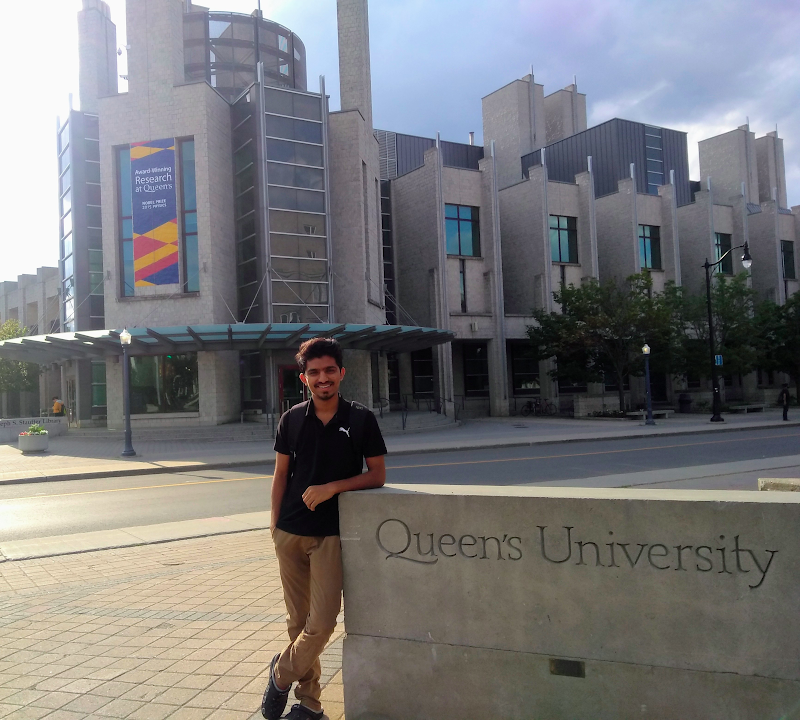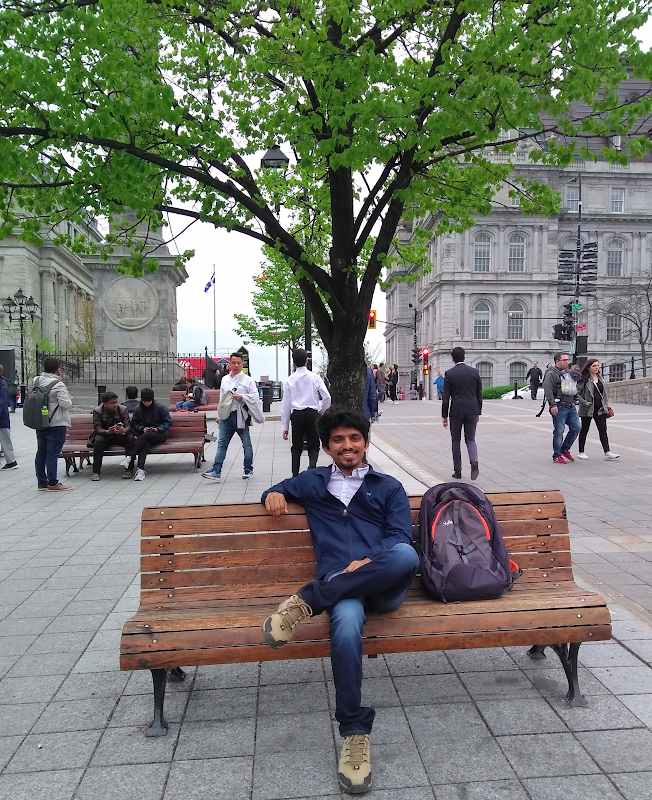

Body of IITR

I have tried to summarize my 12 week-long research experience at Queen’s University, Canada in which I explain the MITACS application procedure in detail and my major takeaways and experiences from my internship at Canada.
It all started back in my second year summers at IIT Gandhinagar, where I had interned in the field of Image Forensics (Computer Vision) which instigated my interest in the field and I considered choosing research as an option. After that internship, I got a basic understanding of what goes into research but still wanted to try my hands on a proper research internship. Of course, I wasn’t completely sure because I didn’t want to miss out on-campus internships as focusing only on getting a research internship is a huge risk if you opt-out of the campus internship process. Considering the fact that a very limited number of deep learning-based companies/startups visit the campus, the chances for me were less. Eventually, I got selected for Robert Bosch’s Deep learning division during Mid September.
Along with my on-campus preparations, I was constantly applying for Research Programs. I applied to a lot of programs including DAAD, SN Bose, Viterbi, MITACS and a few others. I got the invitation from a german professor but due to DAAD’s strict CGPA cut-off, I could not get the scholarship. These programs generally have their deadlines during the autumn semester. After 2-3 interviews, I got my selection mail from MITACS in the first week of January.
MITACS Globalink is a Research Internship Program funded by MITACS Canada which invites undergraduate students from all around the globe to pursue research for 12 weeks in a Canadian university. It is open for the 3rd year and above students in India with a minimum CGPA of 7.5 (80 %). The amount of funding you receive is the highest among all the other programs (~ 8000 CAD). So, you can easily visit a lot of places in Canada and still save money. One of the major advantages of this program in comparison to other programs is that you can get a MITACS Graduate fellowship (~15000 CAD) for doing masters/PhD in Canada.
The application portal of MITACS is simple where they ask your basic details. Then, you have to write your research rational (SOP), previous research internship experience, and a general description of your skillset in about 100 words each. Yes, you have to write your SOP in about 100 words only. So, be as precise as possible. You also have to submit 2 letters of recommendation from your professors/supervisors whom you have worked with along with your CV and transcripts. Lastly, you have to give 7 preferences of project/professor you want to work with, in your preference order. Seriously, that was the most difficult part. You are given a list of around 2500 projects from which you have to select only 7 and all 7 projects combined should be in at least 3 different Canadian provinces (states). The applications generally open in early August and the deadline is around mid-September.
The selection process is carried out in two phases. The applications of the students selected in the first phase are sent to the respective professors. During that time Phase-2 students are waitlisted and have to wait till the phase-1 process is over and then their profiles are sent. MITACS doesn’t reveal how they separate students, but based on previous interns and my experience, they shortlist you on the basis of overlap between your interests and the projects which you have chosen along with many other factors such as CGPA. Being waitlisted in the first stage is a big disadvantage as it might be possible that the professor of your choice has already selected someone else during phase-1. So, try to fill the projects with relevance to your previous work/experience so that you get selected in the first phase. After that, your profiles are sent to your respective professors. It solely depends on the professor to have an interview for selection or not. I had many friends who directly got the offer without a single interview and some who had as many as 5-7 interviews. I had 3 interviews for my different projects. Luckily, I got selected by the professor on my 1st preference. The interviews are easy and revolve around your previous projects/ internships from your resume along with a short discussion about the current project. Also, do show your interest for higher studies, professors prefer students who can extend their project in their masters/ PhD and work with them for a longer duration. The procedure after you receive the offer is straightforward and most of the cases students get their visa approved in 15-20 days due to the funding from MITACS.

Kingston is a small city on Lake Ontario located in the province of Ontario. A city far from the hustling life in large cities like Toronto and Montreal, it gives you a small-town vibe. There aren’t many exciting things to do in Kingston but it is a 3-hour ride to both Toronto and Montreal and 2-hour ride to the capital city (Ottawa). The Queen’s University was found in the mid 19th century, hence you can find a glimpse of the 19th-century British architecture in many departments. In fact, very few people know that Kingston was the first official capital of Canada.
Queen’s University has a quiet and relaxed atmosphere. Consider it a perfect place to spend your summers. Due to the small area and limited population, there won’t be anything bustling around but instead, you can experience a countryside vibe far from the hectic and fast-paced life. You can spend your evenings in the Lake Ontario Park reading your favourite book and take a walk along the lake.
I stayed in a large house close to the downtown area with my friends. We got the entire house (6 bedrooms) to ourselves as houses are generally available on lease during the summers. I searched for accommodation through the Queen’s off-campus housing facebook group. Kijiji is also a good website to find accommodation in Canada.
The people in Canada are considered to be one of the nicest and most polite across the globe. It is very common to find people greeting you on the streets and engaging in conversations. There are a lot of places to eat out but believe me, after a few weeks, I was exhausted and decided to cook on my own. I had never made a dish on my own before. But eventually, I got better at it and I can say that now I can make a decent meal for myself. So, do carry some basic spices and utensils and learn some basic cooking techniques. For recipes, youtube is always there to the rescue!
The project which I was assigned was in the field of Computer Vision where I had to develop various models for the task of skeleton-based Human Action Recognition. As evident from the name, out of a given video involving a person doing some kind of activity, the task was to accurately predict real-time action. This type of work has its applications in security surveillance (identifying robbery, attack etc) and elderly homes/hospitals (for patient monitoring).
There were no fixed timings to work as long as you deliver/update with the progress of the project. My lab was primarily focussed towards Data Mining and Analytics but was shifting its focus towards modern deep learning applications. We had weekly group meetings every Wednesday where we had to present our progress or anything interesting paper/tech that you have read. My first month was focused on reading the state of the art papers in the field of Activity Recognition and preparing proper literature review which is further useful for final reports. Then in the subsequent months, I was involved in preprocessing the data. Believe me, most of the time you are involved in preprocessing and removing errors from your code, the actual time where you do the hyped deep learning stuff is actually very less. Further, I developed and tested two different LSTM and CNN based models for the task. As there is no physical experimentation required, each of us had a GPU enabled server, which we could use it from any place.

Considering the location of Kingston, you can easily have weekend plans to Toronto, Montreal and neighbouring cities. I mainly visited Montreal, Ottawa, Toronto, Niagara Falls and a Mountain trail near Kingston. The best of all the places were definitely Toronto and Niagara falls as I went there during the Canada Day Weekend. We were lucky enough to witness the Canada Day fireworks from the Niagara Falls on the boat. Canada Day celebrations in the centre of Toronto city (Eaton Square) gives you the vibe of an Indian Mela. Every person wearing Red and holding Canadian flags in their hand. One thing which I noticed is that people in Canada are a lot more patriotic towards their country, you can easily find big Canadian flags in their houses and public places. Of course, the cities in Ontario don’t offer the natural scenic beauty compared to Alberta and British Columbia but still, it is a great experience. One place which I do recommend visiting if you have time is Banff, Alberta and some parts of British Columbia where you will find the most scenic places on earth.


A 12-week long research internship in a foreign land not only gives you a proper head start to your research career but also makes you realize the true meaning of living independently. Compared to our college lives, where most of the things are taken care of, you will have to manage most of the things including grocery, food, house along with your work on your own. One of my major takeaways from this internship is that you get out of your comfort zone and push yourselves to unknown territories. Believe me, it’s very difficult to get out of your comfort zone and break your normal flow of life but it makes you a much more independent person where you meet a lot of new people, roam around in an unknown country, cook your own food.
One of the NITs had 45 students selected this year for the program, compared to around 5-6 from our institute. So, I would encourage people to at least give it a try and apply for the MITACS program as it is definitely worth it in the end. Do give it a try!